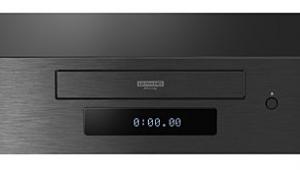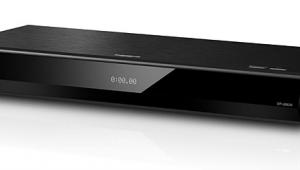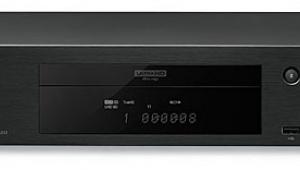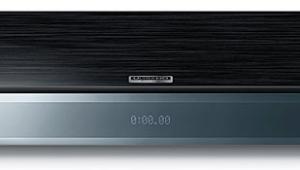Samsung BD-P1200 Blu-ray Player
While the in the end, Samsung's first foray into the Blu-ray world wasn't the major culprit in said format's poor picture quality (turns out most of the early discs just didn't look very good), it was still rather lackluster. It didn't upconvert DVDs very well, it didn't offer a 1080p/24 output, and it didn't decode any of the new audio formats. With its second-generation offering, Samsung has fixed most of these shortcomings. Most.

Prettier, Prettiest
Looks wise, the $649 BD-P1200 is a lot more upscale than the more expensive (at launch), BD-P1000. It's still a little plasticy looking, but there are many players that cost more and look cheaper. The remote looks the same as every other Samsung remote we've seen recently. It isn't very good, but it isn't very bad. Thankfully, a few of the buttons glow in the dark.
It takes about 54 seconds to go from off to when you first see video on the screen. There are a few players that are faster, but there are also some that are slower.

Like Toshiba's excellent HD-XA2, the BD-P1200 uses Silicon Optix' REON chip. As such, it offers excellent scaling and processing. This chip, while not cheap, is one of the best going at the moment for video processing. This is why you can find it in many high-end products from TVs to AV receivers.
As you'd expect, the BD-P1200 sails through all of SO's own HQV Benchmark tests, both in DVD and Blu-ray forms. This includes correctly deinterlacing 1080i and 480i, and picking up the 3/2 cadence from film-based material with both as well. The 1080i aspect of this, while welcome, is not the big deal it is on the TV side of things. This is because nearly all BDs are 1080p native on the disc. So the only time you'd need to de-interlace 1080i is if you're watching a concert video, perhaps some HD extras, or if the player is interlacing the 1080p on the disc (which doesn't seem to be the case here, though there is no way to tell for sure). On the waving flag scene on the HQV Benchmark DVD, the flag showed essentially no jagged edges.
But only putting a processor through tests designed by the manufacturer of said processor would be pretty ridiculous. So we put in our standard test discs as well. Our best standard discs looked excellent, revealing about as much detail as you'll see on an upconverted DVD. There was also very little noise, which is a difficult feat to do with this much detail. Gladiator also looked good, with fast 3/2 pickup.
 With Blu-ray at 1080p/60, the difficult stairway shot at the beginning of chapter 8 of Mission: Impossible III looks as clean as I've seen it. Other discs, like Black Hawk Down looked as detailed as you'd expect from this new format.
With Blu-ray at 1080p/60, the difficult stairway shot at the beginning of chapter 8 of Mission: Impossible III looks as clean as I've seen it. Other discs, like Black Hawk Down looked as detailed as you'd expect from this new format.
24p
Like most of the BD players on the market, the BD-P1200 offers a 1080p/24 output. This is one of the big features many people are looking for these days (along with a 1080p/24 input on their TVs). The number of people that can actually take advantage of this is very small, as most TVs can't change their refresh rate to a multiple of 24 (which would be the only time you'd really see an advantage). In the display setup menu is a "Movie Frame (24Fs)" option that enables this. If your TV can't accept 1080p/24, don't bother with it.
What the BD-P1200 doesn't have is the ability to decode any of the next generation audio formats such as Dolby Digital Plus, Dolby TrueHD, or DTS-HD Master Audio. Most (but not all) BD discs at the moment feature uncompressed PCM as the high-resolution audio choice, so this isn't a deal breaker for me. But other players on the market, such as the Pioneer Elite BDP-HD1 and Panasonic's DMP-BD10A, do offer next-gen audio decoding. That said, Samsung is coming out with a BD-P2400 this fall that does all that the BD-P1200 does, plus Dolby TrueHD and DTS-HD MA decoding. Not quite as good as a few of the more audiophile BD player choices, but it's a step in the right direction.
Worth a bit more?
As prices come down in the BD world, many will question paying a premium for players like this. For that matter, the PlayStation3 offers upconversion of standard def DVDs and a 1080p/24 output for less, and does a lot more. As most people will still be watching a substantial amount of DVDs for the foreseeable future, this player is one of the best choices for watching them. It's one of the best upconverting DVD players you can buy, and in addition it will play Blu-ray movies. So yes, it's worth the premium for any videophile.
For a comparison of this player to the Sony BDP-S300 and the Panasonic DMP-BD10A, check out HT's October print issue.
Highlights
• Excellent Processing
• The HD-XA2 of the BD world
• A fantastic upconverting DVD player as well
- Log in or register to post comments



























































